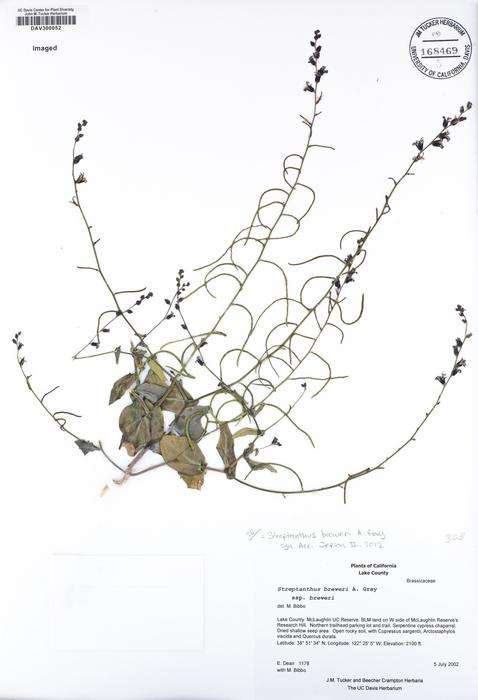As the earth’s climate continues to shift, understanding how species adapt—or fail to adapt—to changing environmental conditions remains a cornerstone question in evolutionary biology. A groundbreaking study from researchers at the University of California, Davis, has brought new insights into this complex dynamic by examining a wildflower clade known as jewelflowers (Streptanthus). This research, published recently in the prestigious Proceedings of the National Academy of Sciences, challenges preconceived notions about the adaptive capacity of plant species and highlights the underestimated value of herbarium specimens in ecological research.
Jewelflowers originated in the arid deserts of the American Southwest, environments characterized by extreme heat and dryness. Over the past two to four million years, these plants expanded their range into California, a region with markedly different climatic characteristics—most notably a Mediterranean climate marked by wet winters and arid summers. Traditionally, it was assumed that species migrating into such contrasting environments would undergo significant evolutionary adaptation to thrive under these new conditions. However, this study reveals a surprisingly constrained adaptation, whereby jewelflowers have not dramatically altered their seasonal niches despite the vast differences in ambient climatic conditions.
The team, led by Sharon Strauss, a Distinguished Professor emeritus in the Department of Evolution and Ecology at UC Davis, embarked on an ambitious project that leveraged an immense dataset of nearly 2,000 herbarium specimens representing 14 species of jewelflowers. These specimens, collected over many decades and housed within the Consortium of California Herbaria, carried vital metadata including precise locations and collection dates, allowing the researchers to reconstruct historical local climates corresponding to the growth periods of individual plants.
.adsslot_3W4SIhFBEs{width:728px !important;height:90px !important;}
@media(max-width:1199px){ .adsslot_3W4SIhFBEs{width:468px !important;height:60px !important;}
}
@media(max-width:767px){ .adsslot_3W4SIhFBEs{width:320px !important;height:50px !important;}
}
ADVERTISEMENT
Crucially, jewelflowers are annuals that germinate with the onset of seasonal rains and complete their life cycle before the dry summer sets in. By cross-referencing collection dates with local climatic records, the team was able to deduce the timing of germination and flowering for each specimen, effectively reconstructing the “lived environment”—the specific microclimatic conditions experienced by the plants during their active growth phase. This undertaking went beyond broad-scale climate averages to examine fine-scale temporal and spatial climatic dynamics.
The analysis yielded compelling results. While the annual climatic averages across the species’ distribution varied widely—spanning cooler, wetter northern locales to hotter, drier southern areas—the jewelflowers themselves consistently occupied temporal niches characterized by warmer and drier conditions than the annual averages of their respective regions. This suggests that rather than evolving to tolerate entire climates, jewelflowers exploit microhabitats and seasonally specific windows that approximate the environmental conditions of their ancestral desert origin.
Such findings have profound implications for our understanding of ecological niche evolution and species persistence under climate change. Contrary to expectations that species expand their climatic tolerance over evolutionary timescales, jewelflowers demonstrate a constrained seasonal niche that is maintained through strategic phenological timing and habitat selection. For example, some populations preferentially inhabit south-facing slopes that receive higher solar radiation or occur in areas with drier soils, effectively enabling them to “track” warmer and drier conditions within broadly cooler and wetter landscapes.
The study underlines the critical role that microclimates and phenological plasticity play in buffering species against macroclimatic variability. The capacity of jewelflowers to “feel out” and exploit these microclimatic refuges demonstrates a nuanced adaptive strategy that does not necessarily require extensive genetic evolution but relies on finely tuned life cycle timing. This insight also cautions against simplistic models of species’ responses to climate change that consider only annual climate averages, emphasizing the importance of incorporating seasonal and local-scale climate data into predictive frameworks.
Another groundbreaking facet of this research is its demonstration of the untapped potential of herbarium collections for ecological and evolutionary inquiries. Often relegated to taxonomic roles, these specimens, curated for centuries, provide invaluable historical baselines of species’ phenology, distribution, and environmental contexts. By analyzing these preserved snapshots through the lens of contemporary climate reconstruction, the researchers could delve into long-term ecological patterns that would otherwise be inaccessible.
The journal article offers a detailed methodology that integrates specimen metadata with high-resolution climate models to derive precise estimates of germination and flowering timing across multiple species and geographic localities. This multifaceted approach merges classical botany with cutting-edge ecological modeling, setting a precedent for future studies aiming to unravel evolutionary responses to historical climate dynamics.
While jewelflowers exemplify a restrained evolutionary shift in niche breadth, the study’s broader significance lies in its challenge to the prevailing assumption that species readily evolve new climatic tolerances. If this pattern holds across other taxa, the capacity for rapid adaptation to ongoing global warming could be far more limited than anticipated, raising concerns about biodiversity resilience.
The collaborative nature of this work, which includes contributions from postdoctoral scholar Megan Bontrager (now an assistant professor at the University of Toronto), alongside a multi-institutional team including experts from Universidad Nacional Autónoma de México, illustrates the interdisciplinary and cross-border efforts needed to tackle complex ecological problems. Their findings serve as a clarion call for increased integration of historical biological collections with modern data analytics to glean insights on species-environment interactions over evolutionary timescales.
In summary, this research on jewelflowers illuminates the subtle, yet powerful strategies plants employ to survive amid shifting climates, emphasizing phenology and microhabitat use over broad genetic adaptation. This constrained seasonal climate niche highlights both the resilience and vulnerability of species, providing a nuanced understanding critical for conservation and ecological forecasting amidst accelerating environmental change.
Subject of Research: Not applicable
Article Title: Herbarium specimens reveal a constrained seasonal climate niche despite diverged annual climates across a wildflower clade
News Publication Date: 1-Jul-2025
Web References: http://dx.doi.org/10.1073/pnas.250367012
Image Credits: UC Davis
Keywords: Evolutionary ecology, Evolution, Plant sciences, Plants
Tags: arid desert plant evolutionclimate change impact on plantsconservation of plant speciesecological research methodologiesenvironmental conditions and plant growthherbarium specimens ecological importancejewelflowers evolutionary biologyMediterranean climate plant studiesplant adaptation researchplant species resilience to climatespecies migration and adaptationUniversity of California Davis plant study




